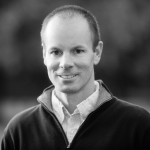How to Make a Tornado: Ideas Emerging from Decades of Theory, Simulation, and Field Observations
Paul Markowski, Penn State University
Tuesday, September 9, 2014 at 2:00 P.M. in the H.J.E. Reid Auditorium
(video of the lecture) within the Langley firewall only
Abstract
This talk will examine the mechanisms of tornadogenesis within atmospheric convection, particularly supercell thunderstorms, which are responsible for virtually all strong tornadoes. It is well known that both environmental and storm-generated vorticity are important in the development of mesocyclones and tornadoes within supercells. Mesocyclones that develop at midlevels in a supercell updraft arise from the tilting of environmental vorticity. On the other hand, the development of rotation next to the ground occurs near the interface of a downdraft and updraft because horizontal vorticity tilted by an updraft alone acquires a vertical component only as it rises away from the surface.
The talk will review the so-called barotropic and baroclinic mechanisms for how downdrafts lead to the development of near-surface rotation, which is a prerequisite for tornadogenesis. Baroclinity and downdrafts appear to be crucial for tornadogenesis, though excessive negative buoyancy inhibits tornadogenesis. The role of of environmental vorticity in tornado formation appears to be indirect (that is, environmental horizontal vorticity does not contribute to the low-level mesocyclone’s vorticity budget in a major way). The talk will conclude by discussing some of the ideas emerging from the recently completely Second Verification of the Origin of Rotation in Tornadoes Experiment (VORTEX2) and directions for future research.
Speaker
 Paul Markowski is tornado researcher and Professor of Meteorology at Penn State. He received his B.S. in Meteorology from Penn State in 1996, and his M.S. and Ph.D. degrees from the University of Oklahoma in 1997 and 2000, respectively. His research uses a blend of cutting-edge observations and computer simulations to better our understanding of how tornadoes work in order to improve warnings. He has authored over 75 journal articles in addition to a best-selling textbook, and has given over 100 presentations within the U.S. and abroad. He is a recipient of the National Weather Association’s Fujita Award, the European Severe Storms Laboratory’s Dotzek Award, the National Science Foundation’s Faculty Early Career Development Award, the American Meteorological Society Editor’s Award, and the Penn State University Alumni Achievement Award. He was one of the principal organizers of the Second Verification of the Origins of Rotation in Tornadoes Experiment (VORTEX2), which was the largest and most ambitious tornado research project of all time. He also is the Chief Editor of one of the world’s leading meteorological journals and was a special consultant to the National Football League for Super Bowl XLVIII.
Paul Markowski is tornado researcher and Professor of Meteorology at Penn State. He received his B.S. in Meteorology from Penn State in 1996, and his M.S. and Ph.D. degrees from the University of Oklahoma in 1997 and 2000, respectively. His research uses a blend of cutting-edge observations and computer simulations to better our understanding of how tornadoes work in order to improve warnings. He has authored over 75 journal articles in addition to a best-selling textbook, and has given over 100 presentations within the U.S. and abroad. He is a recipient of the National Weather Association’s Fujita Award, the European Severe Storms Laboratory’s Dotzek Award, the National Science Foundation’s Faculty Early Career Development Award, the American Meteorological Society Editor’s Award, and the Penn State University Alumni Achievement Award. He was one of the principal organizers of the Second Verification of the Origins of Rotation in Tornadoes Experiment (VORTEX2), which was the largest and most ambitious tornado research project of all time. He also is the Chief Editor of one of the world’s leading meteorological journals and was a special consultant to the National Football League for Super Bowl XLVIII.
PDF flyer suitable for printing.
Norm Schaeffler is hosting our speaker this month.